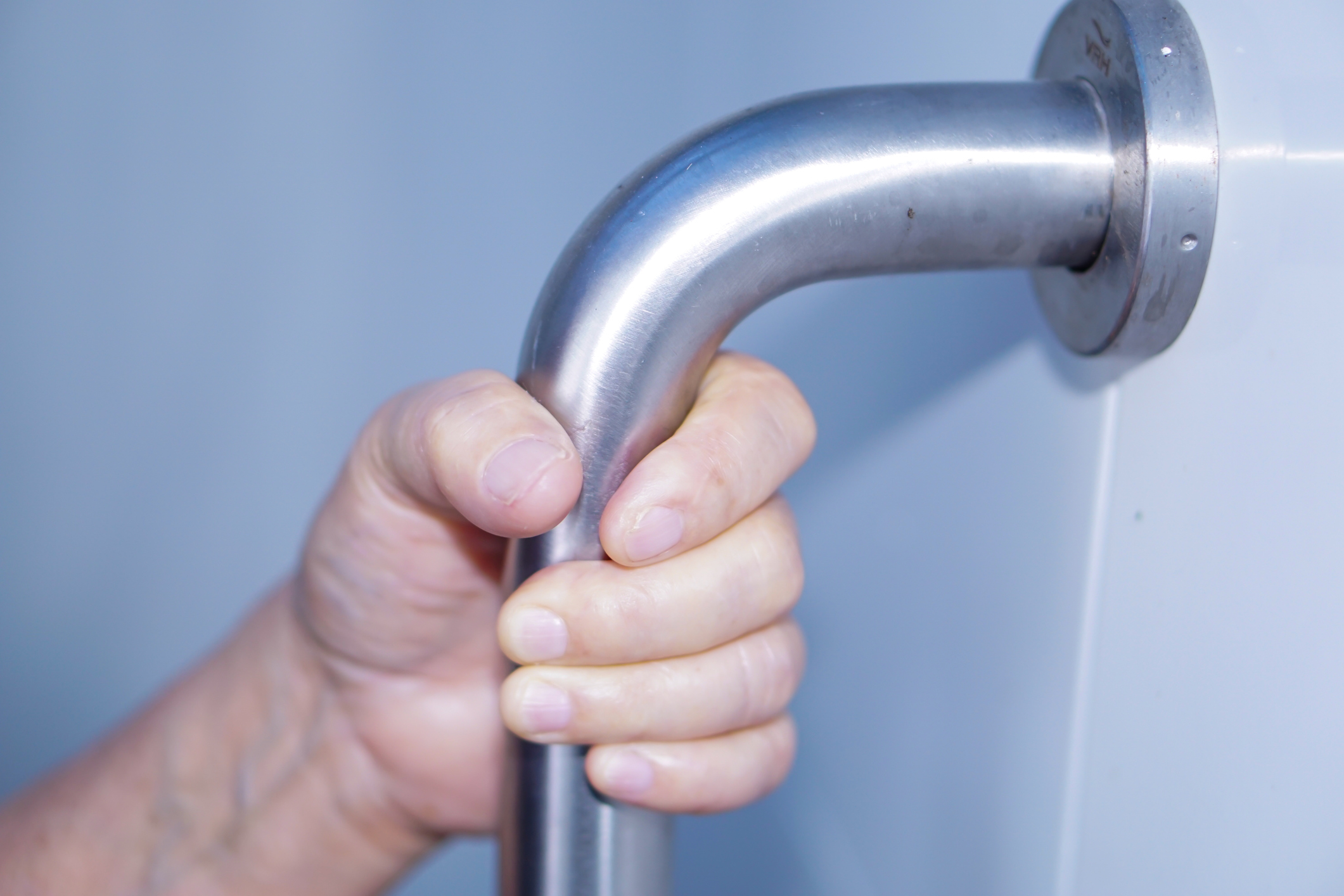How to Make Your Home Safer as You Age
Keeping your home safer as you age in place takes planning and renovations.

That pain in your knees is likely not from bending down in the garden. It may be arthritis, and if so, it is not going away.
Climbing those stairs to get to your bedroom has become a major chore. And it can be painful.
Reaching up to get the paper towels from the top shelf now requires a step stool and sometimes, a prayer.
From just $107.88 $24.99 for Kiplinger Personal Finance
Become a smarter, better informed investor. Subscribe from just $107.88 $24.99, plus get up to 4 Special Issues

Sign up for Kiplinger’s Free Newsletters
Profit and prosper with the best of expert advice on investing, taxes, retirement, personal finance and more - straight to your e-mail.
Profit and prosper with the best of expert advice - straight to your e-mail.
More than 75% of those 50 and older of all races and ethnicities say they want to stay in their homes as they grow old, also known as aging in place, according to AARP.
But aging in place requires a lot more than desire. The home needs to be safe and accessible to avoid accidents and easy to move around in and to enter and exit.
Older adults may know renovations are necessary in bathrooms, bedrooms and kitchens. But they chronically put off projects until crunch time.
“It is a lot easier to think about a time when you need things to be different. There may be a day when I don’t drive, the stairs are going to be hard for me. It is really a good idea for people when they are well, active and healthy to make the changes ahead of time,” says Amy Goyer, a family caregiving expert for AARP.
She is personally going down this road right now as she and her boyfriend renovate a home they hope to reside in as they age. So, in addition to passing along information to her clients, she is making decisions for her own life.
“There are several reasons to prepare in advance, but people tend to drag their feet,” Goyer says. “It is so much better to do it in a preventive way. Sometimes there is a sudden reason, like a fall or stroke or other health conditions. Then all of a sudden you are in a crisis and trying to modify the home.”
Wide range of jobs and costs
There are specialists across the country trained in renovating homes for aging in place. They can do simple jobs, such as adding grab bars and removing thresholds, for $1,500-$5,000, or completely renovate homes or construct additions for a cost of up to $300,000, says Alan Archuleta, CEO of Archuleta Builders in New Jersey. He is the current chair of the remodelers committee for the National Association of Home Builders.
“Typically, in New Jersey, what happens is we get phone calls from children that have aging parents who want a quick renovation because their parents are coming out of the hospital or at a point where their home is not safe. Most times the reason they can afford to do it is because their house is paid for, and the option of long-term care is so much more expensive,” Archuleta says.
“For them, it’s a lot easier to scrape up what they need to do this because it is a lot more realistic than paying for long-term care somewhere else,” he says.
Goyer is in such a position. “I just had a knee replacement, and we are looking ahead,” she says. “We’ll have a lift to avoid the stairs. It really solidified for me to design a home for renovations with aging in place in mind. One term is universal design. It’s smart design, whether it’s for pushing a baby carriage through the house or having a wheelchair or walker.”
Bathrooms take the lead

The most common renovations people should make for aging in place include adding grab bars in bathrooms to avoid falls and having a zero-threshold shower entry. “A lot of falls happen in the bathroom. It is one thing stepping over a bathtub, but even having a low curb makes it harder,” Goyer says. “My dad had Alzheimer’s, and it was hard for him to walk over that threshold.”
Being able to safely enter and exit the home is another need. “Even one step can make it difficult to get into the house,” she says. “You can build a ramp that doesn’t look like a ramp.”
Archuleta recently built such a ramp in New Jersey. “We ended up doing an addition for a family with a first-floor master suite, and then we were able to build a ramp with the addition so the man could get in and out of the house.” The client has recently been diagnosed with Parkinson’s disease and was going downhill fast, Archuleta says. He built the ramp inside as part of the addition.
“That was probably a $300,000 renovation because we added square footage,” Archuleta says, “probably 30x30 with a very large master bedroom and bathroom and doors 36 to 42 inches wide.”
His area of New Jersey has one of the highest per capita incomes in the nation, and the money spent on renovations will be key to a great resale, he says. But modest budgets can also be accommodated.
The VEVOR 4-inch rubber threshold ramp makes it easier to navigate doorways with wheelchairs, scooters, or carts. It’s durable, slip-resistant and currently available at Lowe’s for under $100.
Get a checklist
AARP has designed a “Checklist for Aging in Place,” which Goyer says is very popular with people considering remodeling.
The guide recommends starting small by raising toilet heights, so you don't have to bend down so far, and moving things to lower shelves, so you don’t need a stepladder.
Make sure lighting is good in areas such as the kitchen to avoid slipping on spilled liquid. Add lights in the hallways and stairwells.
Make sure the bed is easy to get in and out of. Use risers, if needed. Add drawers or slide-out trays to existing cabinets for easy access. Use chairs with armrests, which make it easier to stand or sit.
Remove electric cords from walking paths. Get rid of slippery throw rugs.
For a room-by-room guide, you can go here. Goyer used some advice from the guide in renovating for her father, she says. “The bathroom I did for my parents is a really good example. One of the sinks was lowered, and the cabinet opens underneath for a wheelchair.”
The Stander Mobility Bed Rail offers sturdy support when getting in and out of bed. The assist bar pivots 180 degrees and swings out 15 inches for added stability. The steel frame supports up to 300 pounds.
Add some technology

According to The Journal Healthcare, technology is “a potential resource to facilitate or improve aging in place.” For example, a technology like telehealth can improve health-related quality of life. Other relevant technology includes sensors for lighting, medication reminders, wearable devices such as pedometers to ensure someone is moving enough, and social media to stay connected to the outside world and boost self-confidence.
There are automatic shutoffs for stoves, flooring with sensors to detect a fall and voice commands so someone can call a neighbor or the police for help. Order groceries online, or set up technology to automatically call a neighbor or family member in the event of an emergency.
“Although the adoption of technology by healthy older adults who are aging in place is a promising and theoretically well-founded idea, there is a lack of high-quality studies in the subject,” the National Library of Medicine says.
Silent Beacon is a Bluetooth-enabled personal safety device that lets you call for help with the push of a button. It connects directly to your phone to alert a contact in an emergency, with no monthly subscription necessary.
Finding someone to do the work
Find aging in place renovation experts through the National Association of Homebuilders, which has a directory of Certified Aging in Place experts, or CAPS. This includes contractors, interior designers, occupational therapists and others. On the filter on the left side of the page, check CAPS, the first option.
Check reviews before choosing a contractor. You can do this at Angi.com. If the worker is licensed, you should also check with your state licensing authority.
The choices and renovations required may become overwhelming at times, but preparing to age in place does not need to be overly complicated if you seek help from family and professionals.
If you are one of the people over 50 who want to stay in their home, make changes for mobility, safety and health before you are in a health emergency. Make a priority list, follow best practices, and make safety your number-one concern.
Renovations, plus the use of technology, may cost thousands of dollars. But it still costs much less than moving into assisted living, something most older adults do not consider their first choice.
Special assistance for veterans

In some instances, there is assistance for people seeking to renovate for aging in place. Veterans who sustained injuries during their military service, for example, can apply for Special Adaptive Housing Grants through the U.S. Department of Veterans Affairs. The criteria to receive a grant includes:
- Loss or loss of use of more than one limb
- Loss or loss of use of a lower leg and lasting effects of a disease or injury
- Blindness in both eyes
- Certain severe burns
- Certain respiratory or breathing issues
Veterans who meet the criteria can receive up to $24,405 this year. You can apply for this using your DS log-on on the VA website.
You can also mail in an application, which you can get by calling 800-827-1000 and asking them to send you Form 26-4555. Mail the completed application to your nearest regional loan center. If you need assistance filling out the form, email the Specially Adapted Housing (SAH) at sahinfo.vbaco@va.gov or call an SAH staff member at 877-827-3702 (TTY: 711).
Related Content
Profit and prosper with the best of Kiplinger's advice on investing, taxes, retirement, personal finance and much more. Delivered daily. Enter your email in the box and click Sign Me Up.
Yvette C. Hammett is a lifelong journalist whose career has focused on environmental issues, growth and development, economic development and the everyday lives of people. Hammett worked as a staff reporter for the Tampa Tribune from 2001 through 2016 and has written for numerous publications covering B2B marketing, growth in Central Florida, culture and business in the Tampa Bay area, national environmental issues for Natural Awakenings magazine and
legal news making headlines across the country, writing for The Legal Examiner.
-
 Premium Rewards Cards: More Perks, Higher Fees
Premium Rewards Cards: More Perks, Higher FeesSome issuers are hiking the annual fee on their flagship luxury credit cards by hundreds of dollars. Are they still worth using?
-
 3 Trips to Escape the Winter Doldrums, Including An Epic Cruise
3 Trips to Escape the Winter Doldrums, Including An Epic CruiseThree winter vacation ideas to suit different types of travelers.
-
 The Retirement Income Trinity: Cash Flow, Longevity and Tax
The Retirement Income Trinity: Cash Flow, Longevity and TaxRetirement income planning is essential for your peace of mind — it can help you maintain your lifestyle and ease your worries that you'll run out of money.
-
 3 Trips to Escape the Winter Doldrums, Including An Epic Cruise
3 Trips to Escape the Winter Doldrums, Including An Epic CruiseThree winter vacation ideas to suit different types of travelers.
-
 What Science Reveals About Money and a Happy Retirement
What Science Reveals About Money and a Happy RetirementWhether you’re still planning or already retired, these research-based insights point the way to your best post-work life.
-
 How to Leave Different Amounts to Adult Children Without Causing a Rift
How to Leave Different Amounts to Adult Children Without Causing a RiftHere’s how to leave different amounts to adult children without causing a family rift.
-
 My Retirement Learning Curve, 1 Year In
My Retirement Learning Curve, 1 Year InA retiree checks in with what they wish they knew early on and what they've changed about their plan one year in.
-
 3 Ways to Stretch the 2026 Social Security COLA For Your Budget
3 Ways to Stretch the 2026 Social Security COLA For Your BudgetThree steps retirees can take to stretch the Social Security COLA to fit their budgets.
-
 Pickleball Injuries are Getting Out of Hand for Some Adults
Pickleball Injuries are Getting Out of Hand for Some AdultsAs more older adults take up pickleball, injuries are on the rise. Here's how you can lower your risk and still have a ball.
-
 Are You Prepared to Live Longer? MIT AgeLab Answers Questions
Are You Prepared to Live Longer? MIT AgeLab Answers QuestionsA new measure of longevity readiness indicates that for many Americans, the answer is no — and suggests what is needed to get on track.
-
 Government Research Cuts Hit Older Adults
Government Research Cuts Hit Older AdultsThe Trump administration has slashed funding for medical research, delaying some treatments and cures for health conditions affecting retirees.


